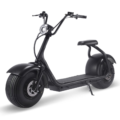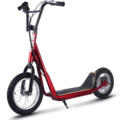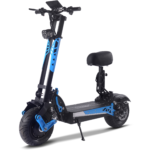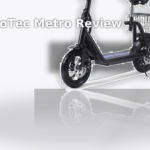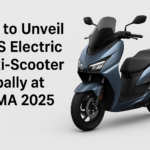- Home
- Scooters
- Electric Scooters
- MotoTec Lowboy
MotoTec Lowboy
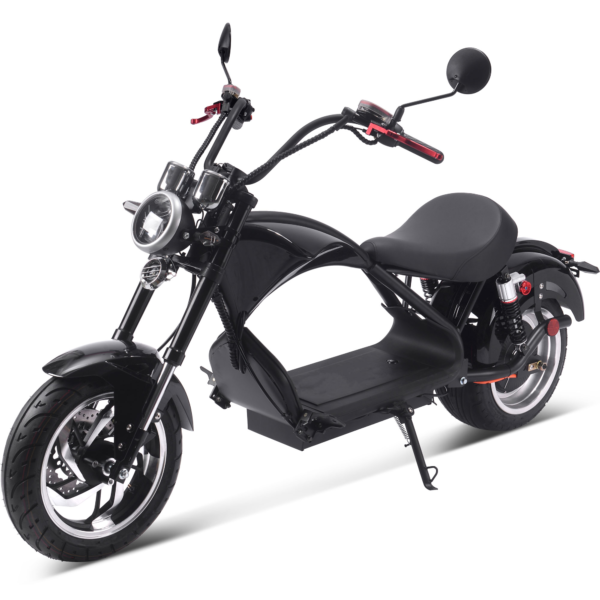


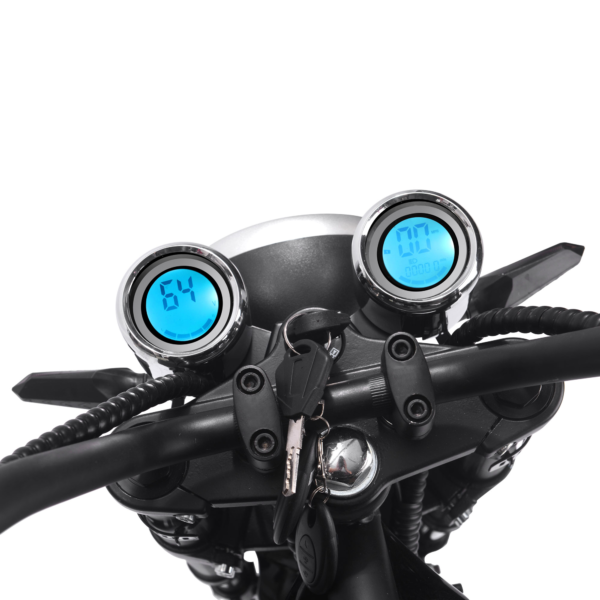
- Battery Range: 25–38 miles (40–61 km)
- Top Speed: 28 mph (45 km/h)
- Motor Power: 2500 W
- Weight Capacity: 300 lb (136.1 kg)
- Charging Time: ~4–8 h
- Scooter Weight: 154.0 lb (69.9 kg)
PROS
- 2500W motor with strong acceleration
- Hydraulic disc brakes front & rear
- Front & rear suspension
- Speedometer, blinkers & horn
- Large tires: 130/70-12 (F), 215/40-12 (R)
CONS
- Heavy at 154 lb (69.9 kg)
- IP rating not specified
- No app/smart features noted
Key Takeaways
- The MotoTec Lowboy is a seated electric scooter designed for comfort and stability, featuring a 2,500-watt hub motor and a top speed of 28 mph.
- Its range is rated between 25–38 miles, and it has a hydraulic disc brake system for reliable stopping power.
- The scooter’s design focuses on a low seat and relaxed posture, making it ideal for urban rides and errands.
- Daily maintenance includes checking tire pressure, brake functionality, and battery storage habits.
- Not suitable for walk-up apartments or off-road use, the MotoTec Lowboy is best for riders needing a comfortable commute and ground-level storage.
Table of contents
- What Is the MotoTec Lowboy?
- How the MotoTec Lowboy Works
- Key Specifications
- Design & Build Quality
- Performance Fundamentals
- Battery, Range & Efficiency
- Ride Quality & Comfort
- Braking & Safety Features
- Portability & Daily Usability
- Maintenance & Care
- Weather & Seasonal Considerations
- MotoTec Lowboy vs Alternatives
- Who the MotoTec Lowboy Is (and Isn’t) For
- FAQs
- Glossary
The MotoTec Lowboy is a seated, chopper-style electric scooter built for calm rides. It rolls out easy, holds speed without drama, and feels planted on city streets. Wide tires and a long wheelbase add that steady vibe, and the hydraulic discs stop with confidence. If you want a quick, human take on the official specifications and real-world behavior, this is it.
What Is the MotoTec Lowboy?
The MotoTec Lowboy is a road-focused scooter with a low seat and a relaxed posture. It behaves more like a small moped than a fold-and-carry kick scooter. The motor sits inside the rear wheel hub, the battery rides low in the frame, and the layout keeps weight balanced. You get LED lighting, turn signals, a twist throttle, and hydraulic disc brakes at both ends. Top speed is rated at 28 mph (45 km/h). Range is listed at 25–38 miles (40–61 km). The scooter weighs about 154 lb (69.9 kg), so it’s a roll-and-park machine, not a shoulder carry. If you want comfort and simple upkeep, it fits the brief.
How the MotoTec Lowboy Works
Every electric scooter has the same core parts. The Lowboy keeps that core simple and sturdy.
Motor. A 2,500-watt brushless hub motor drives the rear wheel. There’s no chain to adjust and no sprockets to line up. It’s quiet and direct.
Controller. The controller reads your throttle input, then feeds the motor the right amount of current. Think of it like a traffic cop for electrons. It smooths starts so the tire hooks up instead of hopping.
Battery. The pack is 60 V and 20 Ah, which works out to about 1,200 Wh. The higher voltage helps hold speed under load. The 20-amp-hour capacity supports longer cruises on flat ground.
Throttle. A right-hand twist throttle sets your pace. Small twist, small push. Bigger twist, more pull. You glance at the gauge and settle into a steady hand once you’re there.
Brakes. Hydraulic discs front and rear. A light lever pull starts the bite, and power builds in a clean, predictable way. Fade is rare in city use.
Lighting and cockpit. LED headlight and tail light, turn signals, horn, and a basic speedometer. A key switch adds simple theft deterrence for quick stops.
Key Specifications
US units first, metric in parentheses.
| Block | Details |
|---|---|
| General | Type: Seated, chopper-style electric scooter; Frame: High-tensile steel; Overall size: 82 × 34 × 40 in (208 × 86 × 102 cm); Intended for recreational road use; Local rules vary |
| Performance & Power | Motor: 2,500 W rear hub (brushless); Top speed: 28 mph (45 km/h); Drive: Rear-wheel; Max rider weight: 300 lb (136 kg) |
| Battery, Charging & Electrical | Battery: 60 V 20 Ah lithium-ion (~1,200 Wh); Range (rated): 25–38 mi (40–61 km); Charge time: 4–8 hours; Throttle: Twist; Key switch: Yes; Lighting: LED head and tail; Turn signals: Yes; Horn: Yes; Speedometer: Yes |
| Build & Dimensions | Frame: Steel; Tires: 12-inch, common fitment Front 130/70-12 and Rear 215/40-12; Suspension: Front and rear shocks; Seat height: 25 in (63.5 cm); Scooter weight: 154 lb (69.9 kg); Folded dimensions: Not foldable (fixed frame) |
| Safety & Control | Brakes: Hydraulic disc front and rear; Visibility: LED lights and turn indicators; Reflective elements: Present; Water resistance: No official IP rating |
| Features & Extras | Adjustable handlebar tilt; Speedometer; Horn; Turn indicators; Cruise control: Not listed |
| Warranty & Compliance | Warranty: 60-day parts replacement; Battery labels: Standard lithium safety markings; Manuals and wiring diagrams available |
These numbers tell a clear story: a planted, seated ride with solid brakes and simple daily use.
Design & Build Quality
The Lowboy borrows its stance from small choppers. Long wheelbase, relaxed front angle, and a very wide rear tire. That layout brings calm steering and easy straight-line tracking. The frame is high-tensile steel with clean welds and even paint. It shrugs off light scuffs from shoes and bags.
You sit low and upright. The 25-inch (63.5 cm) seat height gives most riders a neutral knee bend. The handlebar tilt adjusts so your wrists sit level. The deck stays low, which makes starts and stops smooth. You don’t feel top-heavy at parking-lot speeds, and that cuts stress in tight spaces.
Tires and shocks set the road feel. The front tire tracks predictably on asphalt and concrete. The 12-inch rear is wide, and it spreads load across a big patch of rubber. That wide patch resists spin on dusty paint and takes the edge off small ripples. The front and rear shocks round off sharp cracks and calm pitch when you brake.
Daily details feel sorted. Switches click cleanly, levers pull smooth, and the speedometer sits where a quick glance does the job. The key slot sits out of the way so your knee doesn’t find it.
Performance Fundamentals
The 2,500-watt hub motor gives the Lowboy a smooth launch and a steady middle. Off the line it moves without drama, then digs in as the tire plants. The push to the low-20s mph feels easy. The last stretch to 28 mph (45 km/h) takes longer, which suits a relaxed cruiser. You roll up to pace, settle your hands, and let the motor hum.
Short hills are fine. On rolling grades, the scooter keeps a decent clip with lighter riders. On 7–10% climbs, speed drops and then holds steady if you stay on the throttle. A longer run-up helps on the steeper blocks. Long, steady hills cost range, so budget a margin if your route looks like that every day.
Stability is the Lowboy’s calling card. The long stance and wide rear tire calm quick inputs and cut twitch. Lane changes feel like smooth arcs. Crosswinds and broken city streets bother it less than smaller scooters. The trade-off is a bigger turning circle. Tight U-turns take planning and space.
Noise is low. The hub motor runs quiet, and the steel frame damps buzz. Mostly you hear tire hiss and a light pad scrape when you’re braking hard.
Battery, Range & Efficiency
Energy capacity sets your window. The pack stores about 1,200 Wh. The rated range sits at 25–38 miles (40–61 km). Real-world results float with speed, weight, wind, stops, and temperature. Cruise at 18–22 mph (29–35 km/h) on flat routes, and you’ll land near the middle of that band. Heavier riders, hills, and high speeds shrink it.
You can stretch range with simple habits. Keep tires at the right pressure. Start smooth, then hold a steady cruise. Pick routes with fewer stop signs when time allows. Wind matters more than most riders think, so a tailwind day feels “fast and free,” then the headwind ride home says hello.
Charging takes about 4–8 hours from low. Top up after a ride if you plan to roll again that day. For longer pauses, park indoors and leave the battery near 50–70%. Check it every few weeks and add a short charge if it drifts. Cells stay happier when they avoid long stints at a full 100% or a deep empty.
Cold cuts range. Expect a 10–30% drop near freezing. Heat can hurt cells if you push and charge back-to-back in the sun. Park in shade when you can, then charge after the scooter cools.
Ride Quality & Comfort
Comfort starts with posture. The upright seat and adjustable bar tilt keep wrists and shoulders relaxed. The shocks take the edge off cracks and joints, and the wide rear adds a damped, planted feel over small ripples.
At speed, the front end feels settled. Stem flex is minor, so you make fewer micro-corrections. Less fiddling at the grips means less neck and shoulder fatigue on a 30–40 minute ride.
On rough alleys or broken concrete, slow down and let the suspension do its job. Wheels are still 12-inch, so square-edged holes deserve respect. Ease up, protect the rims, and the ride stays quiet.
Noise stays in the background. Past about 15 mph (24 km/h), you hear more tire than motor. That quiet makes longer loops feel easy.
Braking & Safety Features
Stopping power matters on a 154-lb (69.9 kg) scooter. The Lowboy runs hydraulic discs front and rear. The levers firm up about halfway into the pull, then stopping force ramps in a smooth line. The front does the heavy lifting, and the rear adds straight-line control.
Practice quick stops in an empty lot. Start at 15 mph (24 km/h), then 20 mph (32 km/h), then 25 mph (40 km/h). Feel the weight shift and learn your lever travel. That practice turns a surprise stop into a routine move.
Lighting and signals improve your odds in traffic. The LED headlight helps drivers see you in daylight and helps you read the road at dusk. The tail light and turn indicators make your plan clear to everyone behind you. A small reflective ankle band adds “pop” from odd angles at night.
There’s no official IP rating listed. Treat rain and puddles with care. Slow down, keep lean small, and skip flooded patches that can hide deep holes. Dry the scooter after wet rides, and let it reach room temperature before charging.
Portability & Daily Usability
The Lowboy does not fold. It’s a roll-and-lock machine. If stairs are part of your day, find ground-level storage or a ramp. A solid U-lock through the frame and a cable through the rear wheel cover the basics. A simple cover helps if you store outside. Pick a spot with light and foot traffic.
For 20–40 minute commutes, the seat and posture make a clear difference. You arrive without sore wrists or tight calves. Short grocery runs work too if you strap a bag low on the deck and keep it clear of the rear tire. Keep loads modest and stable.
Daily checks take two minutes. Squeeze both brakes, test lights and horn, scan tires for cuts, and glance at the gauge. Top up when you plan a longer ride and the battery sits in the lower third.
Maintenance & Care
A quick routine keeps things smooth.
Before each ride
- Check tire pressure with a handheld gauge.
- Squeeze both brake levers and confirm a firm feel.
- Test headlight, tail light, and turn signals.
- Look over bar clamp bolts and axle nuts.
Weekly
- Inspect brake pads with a flashlight. Replace when the friction layer gets thin.
- Spin wheels and listen for rotor rub. Re-center calipers if needed.
- Check for embedded gravel or glass in the tires.
Monthly
- Snug safety-critical bolts with a torque wrench: bar clamp, caliper mounts, axles, and shock mounts.
- Clean lever pivots. Keep any lube away from pads and rotors.
- Inspect wire runs for chafe points and add small guards where cables touch the frame.
Every 3–6 months (or 600–1,000 miles / 1,000–1,600 km)
- Bleed brakes if lever feel turns spongy or travel grows long.
- Replace pads when wear marks fade or bite drops off.
- Check tires for flat spots or sidewall cracks. Replace in pairs if wear is uneven.
Battery habits
- Store indoors in a cool, dry space.
- For breaks longer than a week, leave the pack near 50–70% and check monthly.
- Avoid deep drains to empty and long stays at a full 100% when you can.
Common tools cover most jobs: hex keys, open-end wrenches, a torque wrench, a tire gauge, and a small hand pump. Snap a photo of the wiring diagram and keep it on your phone. Label connectors during deeper work so reassembly is painless.
Weather & Seasonal Considerations
Weather shifts range, grip, and comfort. Small changes help a lot.
Rain. Painted lines and metal plates turn slick. Brake earlier, keep the scooter more upright, and cut lean angles. Wipe rotors after wet rides and let everything dry before you charge.
Cold. Expect less range near freezing. Wear warm gloves so throttle input stays smooth. A tense, cold grip gets choppy and wastes energy.
Heat. Park in shade when you can. Charge after the scooter cools down. High heat plus back-to-back charging isn’t kind to cells.
Dust and grit. Wipe fork legs and shock shafts after dusty rides. Grit wears seals and makes action sticky. A two-minute wipe keeps things smooth.
Storage. A basic cover protects from sun and rain outdoors. At home, give the charger airflow and keep cables tidy to avoid snags.
MotoTec Lowboy vs Alternatives
Think of the Lowboy as a calm cruiser for paved routes. It trades compact storage and light weight for a steady seat, strong brakes, and a planted line.
- Versus compact commuters. Small, folding scooters are easier on stairs and trains and weigh far less. The Lowboy wins on planted feel, braking muscle, and a relaxed posture for longer rides. If you want a simple upright runabout for city hops, the MotoTec Metro fits that role well.
- Versus high-power sport models. Dual-motor rigs hit higher speeds and climb harder. They can ride stiff on small wheels and weigh a lot too. The Lowboy gives up peak thrust but stays comfy and easy to live with.
- Versus off-road builds. Knobby tires and long travel shine on dirt. The Lowboy’s smooth tires and low seat suit streets and bike-friendly roads. If you like the chopper look but want a smaller, lighter package for tight streets, check the MotoTec Mini Lowboy.
If you want low-stress cruising with simple upkeep, pick the Lowboy. If daily stairs, tight buses, or quick fold-downs are part of your life, a smaller scooter fits better.
Who the MotoTec Lowboy Is (and Isn’t) For
Great for
- Riders who want a seated, relaxed ride on paved paths and streets.
- Commutes of 5–12 miles (8–19 km) each way with a charge on one side.
- Students who ride at dusk and want clear lighting and signals.
- Neighborhood errands where comfort matters more than sprints.
- Owners with ground-level storage or a secure outdoor spot.
Not ideal for
- Walk-up apartments without an elevator.
- Multi-modal days that need frequent lifts or tight fold-downs.
- Routes packed with long, steep hills at high speeds.
- Off-road use on loose dirt, deep potholes, or rocky tracks.
FAQs
1) Is the MotoTec Lowboy street legal?
It’s sold as a recreational electric scooter. Rules differ by city and country, and some roads or lanes don’t allow scooters. Check the local rules before riding in traffic.
2) How fast does it go, and how far can it travel?
Top speed is rated at 28 mph (45 km/h). Rated range is 25–38 miles (40–61 km). Real-world numbers shift with weight, wind, hills, and stop-and-go riding.
3) Does it fold for storage or transport?
No. The frame is fixed, and the scooter weighs about 154 lb (69.9 kg). Plan ground-level storage and roll-in parking.
4) What does maintenance look like across a year?
Keep tires inflated, check pads monthly, bleed brakes if feel turns soft, and keep bolts snug. Store the battery in a healthy middle state during long breaks.
5) Does the MotoTec Lowboy have cruise control or ride modes?
Cruise control isn’t listed. You hold speed with the twist throttle.
6) What tire pressure should I run for comfort and range?
Follow the sidewall and the manual. Check weekly. Correct pressure boosts range, keeps steering precise, and cuts flat risk.
7) Where’s a quick “MotoTec Lowboy overview” for a fast decision?
Scan the Key Specifications table and the “Who it’s for” section. Those two give a fast yes-or-no on fit.
Glossary
Amp-hour (Ah). Charge capacity. A 20 Ah pack can, in simple terms, deliver 20 amps for one hour.
Watt-hour (Wh). Energy capacity equal to volts times amp-hours. The 60 V × 20 Ah pack stores ~1,200 Wh.
Controller. The unit that meters current from the battery to the motor based on throttle input and safety limits.
Brushless motor. A motor that uses electronic switching for low friction and long life.
Hub motor. A motor inside the wheel hub. It’s quiet and removes chains from the mix.
Torque. Twisting force at the wheel. More torque helps with starts and short hills.
Hydraulic disc brake. A brake that uses fluid pressure to clamp pads on a rotor. Strong and consistent.
Regen. Short for regenerative braking. The Lowboy relies on hydraulic discs; regen isn’t listed.
Stem flex. Bending in the steering column under load. Less flex helps precision at speed.
IP rating. A dust and water resistance code. No official IP is listed here.
Wheelbase. Distance between wheel centers. A longer wheelbase brings straight-line stability.
Suspension travel. How far shocks can compress. More travel absorbs bigger bumps.
Throttle. The control that sets motor power. A twist throttle uses wrist rotation.
Cold-weather range loss. A drop in ride distance when temps are low due to battery chemistry.
Pad wear line. A groove that shows remaining brake pad material. Replace pads when it fades.
Specifications
General
| Model The Model specifies the exact version or name of the scooter. It helps identify its unique design, features, and specifications within the manufacturer’s product line. Knowing the model makes it easier to compare options, find compatible accessories, or look up support information. | Lowboy |
| Brand The Brand identifies the manufacturer or company that designs and produces the scooter. A trusted brand is a sign of quality, reliability, and good customer support. Well-known brands often have higher standards for safety, performance, and after-sales service, giving you more confidence in your purchase. | MotoTec |
| Release Date The Release Date indicates when the scooter model was officially launched on the market. This helps you know how current the design, technology, and features are. A newer release date often means updated components, improved performance, and the latest safety or smart features. | 18 November 2025 |
| Recommended Age Recommended Age indicates the minimum age range that the scooter is designed for, based on safety, size, and ease of use. Following the recommended age helps ensure that riders can handle the scooter’s speed, weight, and controls comfortably and safely. Always check local laws and use protective gear, especially for younger riders. | 16+ |
Performance & Power
| Motor Power (Wattage) What it means: The motor power, measured in watts (W), shows how strong the scooter’s electric motor is. Why it matters: Higher wattage usually means better acceleration, more torque, and improved performance on hills or rough terrain. For example, a 250W motor is good for flat city roads and light riders, while a 500W or 1000W motor provides more power for faster speeds or climbing steep inclines. | 2500 W rear hub motor (brushless) |
| Top Speed The Top Speed indicates the maximum speed that the scooter can reach under optimal conditions. It’s usually measured on level ground with a fully charged battery and an average rider weight. A higher top speed allows you to travel longer distances faster, but always ensure you ride within legal speed limits and your personal comfort zone for safety. | 28 mph (45 km/h) |
| Battery Capacity Battery Capacity refers to the total amount of energy the scooter’s battery can store, usually measured in ampere-hours (Ah) or watt-hours (Wh). A higher battery capacity means you can ride longer distances on a single charge, reducing the need for frequent recharging. Keep in mind that actual range can vary depending on rider weight, terrain, speed, and weather conditions. | 60 V 20 Ah (≈1,200 Wh) — Lithium-ion |
| Estimated Range per Charge The Estimated Range per Charge indicates the average distance the scooter can travel on a single full battery charge. This range is calculated under optimal conditions, such as flat terrain, moderate speed, and average rider weight. Real-world range may vary depending on riding style, terrain, weather, and load. A longer range means fewer recharges and greater freedom for longer trips. | 25–38 miles (40–61 km) |
| Hill Climb Ability Hill Climb Ability describes the maximum incline or slope that the scooter can handle while maintaining stable performance. It’s typically expressed as a percentage or in degrees. A higher hill climb rating means the scooter can tackle steeper hills without losing too much speed or power. Actual climbing performance may vary based on rider weight, battery charge, and terrain conditions. | Up to 18° (~32%) |
| Drive System The Drive System refers to how power from the motor is delivered to the wheels. Electric scooters typically use either a hub motor (directly integrated into the wheel) or a chain/belt drive system. A high-quality drive system ensures smooth acceleration, efficient power transfer, and low maintenance. The choice of drive system affects performance, noise level, and overall ride experience. | Rear hub (RWD) |
Charging & Electrical
| Charging Time Charging Time indicates how long it takes to fully recharge the scooter’s battery from empty to 100% using the standard charger provided. Faster charging means less downtime and more time on the road. Actual charging time may vary slightly depending on battery capacity, charger output, and environmental conditions. | Approx. 4–8 hours |
| Battery Type Battery Type refers to the specific technology used in the scooter’s battery, which affects performance, lifespan, weight, and charging time. Most modern electric scooters use high-quality lithium-ion (Li-ion) batteries because they offer a good balance of energy density, durability, and low maintenance. A reliable battery type ensures consistent power delivery and longer riding ranges. | Lithium-ion pack |
| Removable Battery A Removable Battery means the battery pack can be easily detached from the scooter for convenient charging and replacement. This feature allows you to charge the battery separately, swap it with a spare for extended range, or securely store it indoors in extreme weather. Removable batteries add flexibility and make it easier to keep your scooter powered up wherever you are. | Non-removable internal battery (fixed pack) |
| Regenerative Braking Regenerative Braking is an energy-saving feature that converts some of the energy normally lost during braking back into battery power. When you slow down or brake, the motor works in reverse to generate electricity, which helps extend the scooter’s range and improves overall efficiency. This system also reduces wear on traditional brake components, leading to lower maintenance over time. | No |
| Lighting Lighting refers to the built-in front and rear lights that enhance visibility and safety when riding in low-light conditions or at night. Good lighting helps you see the road ahead and ensures that other road users can see you. Many scooters include LED headlights, taillights, and sometimes brake lights or side reflectors for added safety and compliance with local traffic regulations. | Front & rear LED lights; blinkers; horn |
Build & Dimensions
| Scooter Weight Scooter Weight refers to the total weight of the scooter when fully assembled, including the battery. This affects how easy it is to carry, lift, and store the scooter when not in use. A lighter scooter is more portable and convenient for commuting, especially if you need to carry it upstairs or onto public transport. Keep in mind that a sturdy frame and quality components may add to the weight but also contribute to better durability and ride stability. | 154.0 lb (69.9 kg) |
| Maximum Rider Weight Maximum Rider Weight indicates the highest rider weight that the scooter is designed to safely support while maintaining optimal performance and stability. Staying within this limit helps ensure reliable acceleration, braking, and climbing ability, and it protects the frame, suspension, and motor from excessive strain. Exceeding the recommended limit may reduce performance and increase wear on components. | 300 lb (136.1 kg) |
| Deck Size Deck Size refers to the dimensions of the scooter’s standing platform. A wider and longer deck provides more foot space, allowing you to stand comfortably and adjust your stance while riding. A well-sized deck improves balance and stability, especially on longer rides or at higher speeds. Compact decks, on the other hand, help keep the scooter lightweight and portable. | Cruiser lowboy geometry; wide seat |
| Handlebar Height Handlebar Height refers to the distance from the deck to the handlebars, which affects your riding posture and comfort. An appropriate handlebar height helps you maintain good balance, reduces strain on your back and arms, and makes steering more comfortable. Some scooters have adjustable handlebars to fit riders of different heights, while others have a fixed height for a streamlined design. | Tilt adjustable |
| Folding Mechanism The Folding Mechanism describes how easily and securely the scooter can be folded for carrying and storage. A well-designed folding system lets you quickly collapse the scooter into a compact size, making it convenient to transport on public transit, store under a desk, or fit into a car trunk. Look for sturdy latches and safety locks to ensure the scooter stays firmly in place when folded or unfolded. | Non-folding frame |
| Dimensions Folded Dimensions indicate the size of the scooter when it’s fully folded. This measurement shows how much space the scooter will take up when stored or carried, making it easier to check if it will fit in your car trunk, under a desk, or in a closet. Compact folded dimensions are ideal for commuters who need to bring their scooter on public transport or store it in tight spaces. | Unfolded: 82.0 × 34.0 × 40.0 in (208.3 × 86.4 × 101.6 cm); Folded: Not specified |
| Material Material refers to the primary construction materials used for the scooter’s frame and key components. High-quality materials like aircraft-grade aluminum, reinforced steel, or durable composites provide strength, stability, and a lighter overall weight. A sturdy material ensures the scooter can handle daily wear and tear while maintaining safety and performance. | High-tensile steel |
Safety & Control
| Brake Type(s) Brake Type(s) describe the braking systems the scooter uses to help you slow down or stop safely. Common brake types include mechanical brakes (like drum or disc brakes), electronic brakes, and foot brakes. Many scooters combine multiple braking systems for added safety and shorter stopping distances. The type and quality of brakes affect your control, especially when riding at higher speeds or on slopes. | Hydraulic discs front & rear |
| Suspension Suspension refers to the system that absorbs shocks and vibrations while riding, providing a smoother and more comfortable ride over uneven or rough surfaces. Scooters may have front suspension, rear suspension, or dual suspension for better shock absorption and stability. Good suspension helps reduce rider fatigue and improves control, especially when riding on bumpy roads or off-road paths. | Front & rear shocks |
| Tire Type Tire Type refers to the kind of tires the scooter uses, which directly affects ride comfort, traction, and maintenance. Common types include solid (airless) tires, pneumatic (air-filled) tires, or hybrid options. Pneumatic tires offer better shock absorption and a smoother ride on rough surfaces, while solid tires are puncture-proof and require less upkeep. The right tire type helps ensure safe handling and a comfortable ride in different conditions. | Front 130/70-12; Rear 215/40-12 |
| Tire Size Tire Size indicates the diameter and width of the scooter’s tires, which affect ride comfort, stability, and how well the scooter handles different terrains. Larger tires generally offer better shock absorption and a smoother ride over bumps and rough surfaces, while smaller tires keep the scooter lighter and more portable. Choosing the right tire size helps ensure a balance between agility and comfort. | 12-inch rims (front & rear) |
| Kickstand The Kickstand is a built-in stand that allows you to park your scooter upright when it’s not in use. A sturdy kickstand keeps the scooter stable and prevents it from tipping over, protecting it from scratches and damage. It also makes storing and accessing your scooter more convenient, whether you’re at home, work, or on the go. | Not specified |
| Water Resistance Rating Water Resistance Rating indicates how well the scooter is protected against water and moisture, usually shown as an IP (Ingress Protection) rating. This rating helps you understand whether the scooter can handle light rain, splashes, or wet roads without damage. While most scooters are not fully waterproof, a good water resistance rating adds peace of mind when riding in changing weather conditions. Always avoid deep puddles or submerging the scooter to protect its electrical components. | Not specified |
Features & Extras
| Display/Console The Display (or Console) shows important real-time information about your ride, helping you monitor your scooter’s status at a glance. Typical displays show speed, battery level, distance traveled, and riding mode. Some models also include additional features like Bluetooth connectivity, app integration, or backlighting for better visibility at night. A clear and easy-to-read display enhances safety and convenience on every trip. | Speedometer |
| Ride Modes Ride Modes refer to the different speed and power settings you can choose to match your riding style or road conditions. Common modes include eco for maximum range and energy efficiency, standard for everyday balance, and sport or turbo for higher speed and stronger acceleration. Switching between ride modes allows you to customize performance, conserve battery, and ride safely in various environments. | Not specified |
| Smart App Connectivity Smart App Connectivity lets you pair your scooter with a dedicated mobile app via Bluetooth. Using the app, you can monitor real-time ride stats like speed, battery level, and range, adjust settings such as ride modes or cruise control, lock the scooter for added security, and sometimes receive firmware updates. This feature adds convenience and allows you to personalize your riding experience right from your smartphone. | No app |
| Anti-Theft System The Anti-Theft System helps protect your scooter from unauthorized use or theft. This feature can include built-in alarms, electronic motor locks, GPS tracking, or remote locking through a mobile app. A good anti-theft system provides peace of mind when parking your scooter in public spaces, adding an extra layer of security to safeguard your investment. | Keyed ignition |
| Cruise Control Cruise Control allows you to maintain a steady speed without continuously holding the throttle. This feature makes longer rides more comfortable by reducing hand fatigue and providing a smoother, more relaxed riding experience — especially on flat, open roads or bike lanes. For safety, cruise control can usually be easily activated or deactivated while riding. | No |
| Accessories Included Accessories Included lists the additional items that come with the scooter to enhance your riding experience and convenience. Common accessories may include a charger, kickstand, bell, lights, phone holder, or carrying strap. These extras add value by making your scooter safer, easier to use, and ready to ride straight out of the box. | Not specified |
Warranty & Compliance
| Warranty Period The Warranty Period indicates how long the manufacturer guarantees the scooter against defects in materials and workmanship under normal use. A good warranty provides peace of mind, showing the brand’s confidence in its product quality. Always check what parts are covered, such as the frame, battery, and motor, and follow the maintenance guidelines to keep your warranty valid. | 60 days parts replacement |
| Certifications Certifications confirm that the scooter meets specific safety, quality, and environmental standards set by recognized organizations or regulatory bodies. Common certifications may include CE, RoHS, UL, or other local compliance marks, depending on your region. These certifications ensure that the scooter is manufactured to high standards and is safe and legal to use in your country. | Region-dependent |


